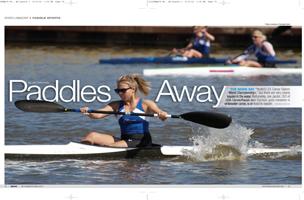
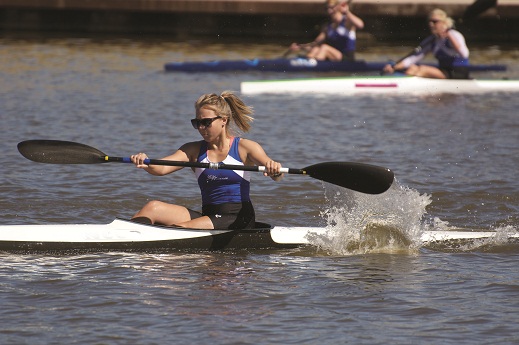 |
| Photo courtesy of Georgia Read |
The signs say “Youth/U-23 Canoe Slalom World Championships,” but there are very clearly kayaks in the water. Fortunately, Joe Jacobi, CEO of USA Canoe/Kayak and Olympic gold medalist in whitewater canoe, is on hand to explain.
“In America, we distinguish between canoe and kayak events, but in most other countries, a kayak is considered a type of canoe,” says Jacobi. “The distinction isn’t made in world events, although we get special permission from the International Canoe Federation (ICF) to use the word kayak in American events. We want people to know what sport to expect, after all.”
This is Wausau, a town in central Wisconsin, home to around 40,000 people and, according to the Wausau Kayak/Canoe Corporation, "one of the nation’s best slalom courses.”
“Whitewater Park is an important part of our community’s identity and we are honored to welcome back an international sporting event that hasn’t been in the United States in over a decade,” says Darien Schaefer, executive director, Sports Authority, Wausau/Central Wisconsin Convention and Visitors Bureau.
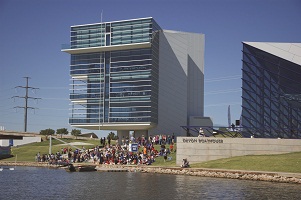 |
| Photo courtesy of Georgia Read |
Whitewater Park opened in the mid-70s, turning the east channel of the Wisconsin River, which runs through downtown Wausau, into a whitewater canoe/kayak course to draw competitors from all over the world. This summer, with the Youth/U-23 Canoe Slalom World Championships in town, it is clear that Wausau’s whitewater vision is alive and thriving.
In fact, paddle sports of all kinds are thriving, with some communities, like Wausau, using their natural resources and others constructing artificial purpose-built paddling courses to draw an ongoing current of paddlers, both recreational and competitive.
Experience Is Key
A community might have vast lakes and miles of river, but that doesn’t necessarily mean that paddle sports events will be a natural fit. Cities that want to attract paddle sports events can earn a leg up by fostering participation at home.
“A canoe/kayak event takes a lot of coordination and volunteers, so it helps tremendously if you have an experienced paddling community,” says Jacobi. “That community not only has a good sense of how paddlers think, what their needs are, and how to run a safe event, but also they make incredible volunteers.”
Kayaking is an intensely individual sport, Jacobi explains, but once the sport takes hold, it builds an amazing community too. The effect of that community is clear in destinations like Wausau, which has such a strong paddling tradition that Olympians like Jacobi all have fond memories of paddling there.
Franklin County, Virginia, offers another great example.
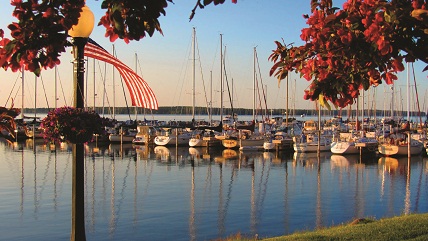 |
| Photo courtesy of Bayfield Chamber of Commerce |
“Our local club, the Creek Freaks Paddlers of Franklin County, holds monthly events where they go out on our county’s rivers and lakes,” says Debra Weir, tourism/special events manager, Franklin County Commerce & Leisure Services. “The Creek Freaks help keep rivers clean, and we don’t know what we’d do without the Paddlers during the Pigg River Ramble. There are only a few people who canoe on staff, and we need volunteers. Creek Freak paddlers will often go down the river on their own with chainsaws to cut trees and clear the course.”
The Creek Freaks Paddlers of Franklin County are members of American Whitewater, a national not-for-profit organization of paddlers, conservationists and paddling clubs that advocate stewardship, safety and outreach in the whitewater community. The American Canoe Association is another similar organization, providing education, encouraging stewardship and developing paddling communities all over the U.S.
But communities that don’t, as of yet, have a paddling club or organization still have a strategy available to them, says Jacobi. His advice is simple: build a boathouse.
“The real long-term game changer is building more boathouses like we have in Oklahoma City,” says Jacobi. “At the end of the day, what’s a boathouse? It’s a community center by the water. We want communities to be more aware of how they intersect with the water. Boathouses provide central locations with access, equipment, coaches and instructors. Plus it’s a way to give kids something to do, a healthy activity, and it literally provides a gateway to the water.”
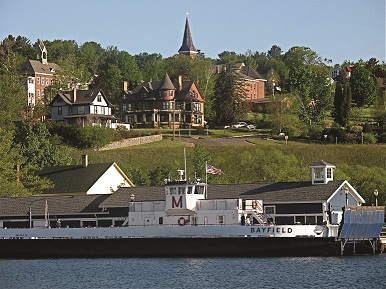 |
| Photo courtesy of Bayfield Chamber of Commerce |
Home to USA Canoe/Kayak, Oklahoma City serves as a model to communities all across the country about how to build a first-rate paddling population. After building its first boathouse in 2006, Oklahoma City now has an entire boathouse district, along with some of paddling’s most prestigious events.
“It’s constantly growing. If you came last year, and then again this year, something is always new in the boathouse district, and that’s indicative of Oklahoma City as a whole as well,” says Sue Hollenbeck, assistant director of sports business development, Oklahoma City Convention and Visitors Bureau.
Oklahoma is in the process of proving Hollenbeck’s words, adding a new light system that will allow for night river events, as well as a $35 million whitewater rafting and kayaking center. A state-of-the-art finish line tower debuted in 2012, and the Oklahoma City Boathouse Foundation has plans in the works for two additional boathouses, bringing the total for the district to four.
Another unique thing about Oklahoma City is their passion for spreading the paddling love.
“Mike Knopp is executive director of the Oklahoma City Boathouse Foundation, and he’s an open book,” says Jacobi. “He shares what he did and how he did it with anyone who wants to know. That’s really good news for anyone who wants to do something that fits in their community.”
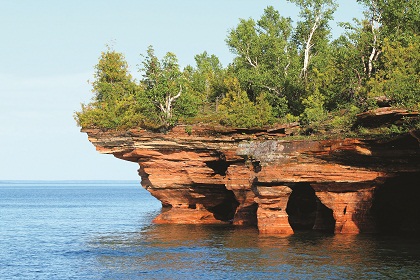 |
| Photo courtesy of Bayfield Chamber of Commerce |
Paddling into the Sunset
In some communities, such as Wisconsin’s tiny resort town of Bayfield, paddle sports are inspired not by extraordinary resources, but by something a bit harder to construct: beauty.
Bayfield is the gateway to the Apostle Islands National Lakeshore, a National Park that includes 21 islands, over 12 miles of shoreline and arguably the area’s most famous feature, sandstone sea caves that take on a crimson glow at dusk and dawn. What’s more, Bayfield has a new waterfront facility, opening up the possibility of bigger and better paddling events.
The 78,000 square-foot Legendary Waters Resort & Casino opened on the shores of Lake Superior in August 2011, a venue offering 47 lakefront view rooms as well as marina and boat launch.
“Legendary Waters is a beautiful facility, and it would make a great option for paddle sports events,” says Erin Johnson, marketing and event manager, Bayfield Chamber of Commerce and Visitor Bureau. “It’s also very close to Living Adventure, which is one of our amazing outfitters in the area. Kayaking is definitely one of our most popular events in the summer, so we’re well-equipped.”
Some of Bayfield’s many outfitters and organizations that serve the demanding summer crowds also offer a unique specialization. Wilderness Inquiry, a not-for-profit organization, headquartered in Minneapolis, aims to “provide outdoor adventure experiences that inspire personal growth, community integration, and enhanced awareness of the environment.” The organization offers sea kayaking and voyageur canoe trips to a variety of destinations around the country, including both the Apostle Islands and Yellowstone National Park and specializes in creating adventure experiences for paddlers with disabilities.
While kayaking is a major tourism activity in Bayfield, the area is also no stranger to hosting kayaking events. The Inland Sea Kayak Symposium took place in Bayfield for many years. The event, created to promote environmental stewardship through education and recreation, is a function of the Inland Sea Society, which advocates for Lake Superior environmental and cultural issues and is currently working in partnership with a number of outside entities to establish a 3,000-mile Lake Superior Water Trail.
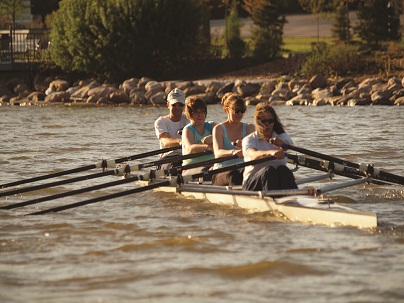 |
| Photo courtesy of Doug Smith/www.torontowide.com |
The Power to Paddle
In Oak Ridge, Tennessee, the Tennessee Valley Authority provides electricity for millions of people in the Southeast at prices below the national average, but they also provide a unique destination for sprint paddle sports.
Melton Hill Reservoir, on the Clinch River, extends almost 57 miles between two dams. Melton Lake, as it is also known, offers amenities that include two boat ramps, one below the dam and one above, and it is also home to the Oak Ridge Rowing Association.
“Melton Lake is a wonderful natural facility. It’s consistently named as one of the top three in the nation,” says Katy Brown, director, Oak Ridge Convention and Visitors Bureau. “It’s very flat. You can see the start from the finish, and it’s one of the only courses in the U.S. where you can do that.”
Its unique dam-and-lock setup allows the TVA to regulate flows during competitions and the surrounding green hills offer a beautiful environment as well as wind protection. The 2000-meter rowing course has hosted several major rowing championships, including U. S. Nationals, Women’s Nationals, Master’s Nationals and the Pan American Trials.
Rowing is not to be confused with paddle sports—rowing uses oars rather than paddles—but the two sports can benefit from similar venues. Oklahoma City’s boathouses, for example, are home to rowing as well as kayak and canoe teams, and Oak Ridge is eager to bring paddle sports to its venue as well.
“We would love to host canoeing and kayaking events, and not just at Melton Lake,” says Brown. “We also have Hall Ridge Park, which is part of the Pellisippi Blue Line canoe trail, and it is certainly set up beautifully for all types of paddle sports and other water events.”
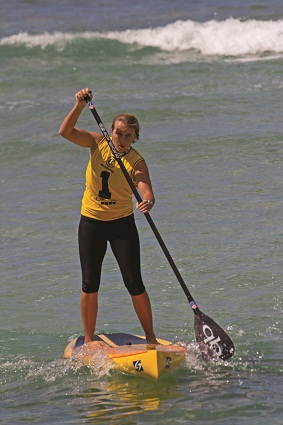 |
| Rico Leffanta/Dreamstime.com |
Stand Up Paddleboard
A lot of sports claim to be the “world’s fastest growing watersport,” and it’s difficult to determine who really deserves that title. But it’s safe to say that stand up paddleboarding, better known by its acronym SUP, is paddling’s phenomenon of the moment. An ancient form of surfing that has its roots in Polynesian culture, SUP is suddenly everywhere, with SUP events and competitions drawing major crowds and participation all over the country.
“We just hosted our first stand up paddleboard competition, the Smith Mountain Lake Stand Up Paddleboard Race,” says Weir. “It was a mile and a half out and back, with a demo on the beach, and let me tell you, it was great exercise. There were kids, adults, even seniors out there. Our partner company brought demo boards, and people were able to try out the sport even if they weren’t racing.”
SUP is the perfect fit for Franklin County, with its already strong base of paddling enthusiasts and more than 70 miles of blueways, but it’s also making appearances at the Olympic level.
“At the 2011 kayak sprint trials at Chula Vista we included a parallel race 200 meter sprint competition for SUP,” says Jacobi. “It was the first time anyone had brought SUP to an Olympic training center. It was good to bring that cool factor of SUP to the trials.”
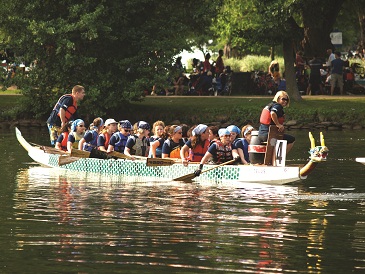 |
| Photo courtesy of Doug Smith/www.torontowide.com |
Dragon Boating
Another candidate in the fastest growing watersport category, dragon boating is a team sport with up to 20 paddlers, a coxswain and a drummer in each elaborately designed boat.
Toronto was on the forefront of the dragon boating trend, and continued the tradition this fall with the 18th Annual Great White North (GWN) Dragon Boating Challenge in September.
“We have a longstanding relationship with dragon boating and a great waterway for the event,” says Robert Kawamoto. “Many people don’t realize this, but Toronto is a lakefront city like Chicago, and watersports of all kinds have a deep history here.”
Home to the 2011 ICF Club Crew World Dragon Boat Championships, along with numerous other paddle sports and watersports events, Toronto makes the most of its history and its waterfront.
Just Hit the Water
No matter whether it’s canoe or kayak, dragon boat or SUP, rafting or even one of the lesser known but growing disciplines like va’a (outrigger canoeing, also with Polynesian roots), the best way to create a paddling community and to draw events to your waterfront is simple: hit the water. Give people paddles and get them on the water. The rest will come with the current.

